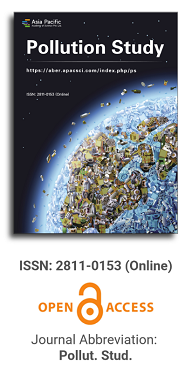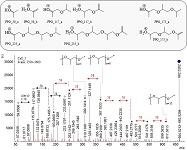
Asia Pacific Academy of Science Pte. Ltd. (APACSCI) specializes in international journal publishing. APACSCI adopts the open access publishing model and provides an important communication bridge for academic groups whose interest fields include engineering, technology, medicine, computer, mathematics, agriculture and forestry, and environment.

The (partial) replacement of synthetic polymers with bioplastics is due to increased production of conventional packaging plastics causing for severe environmental pollution with plastics waste. The bioplastics, however, represent complex mixtures of known and unknown (bio)polymers, fillers, plasticizers, stabilizers, flame retardant, pigments, antioxidants, hydrophobic polymers such as poly(lactic acid), polyethylene, polyesters, glycol, or poly(butylene succinate), and little is known of their chemical safety for both the environment and the human health. Polymerization reactions of bioplastics can produce no intentionally added chemicals to the bulk material, which could be toxic, as well. When polymers are used to food packing, then the latter chemicals could also migrate from the polymer to food. This fact compromises the safety for consumers, as well. The scarce data on chemical safety of bioplastics makes a gap in knowledge of their toxicity to humans and environment. Thus, development of exact analytical protocols for determining chemicals of bioplastics in environmental and food samples as well as packing polymers can only provide warrant for reliable conclusive evidence of their safety for both the human health and the environment. The task is compulsory according to legislation Directives valid to environmental protection, food control, and assessment of the risk to human health. The quantitative and structural determination of analytes is primary research task of analysis of polymers. The methods of mass spectrometry are fruitfully used for these purposes. Methodological development of exact analytical mass spectrometric tools for reliable structural analysis of bioplastics only guarantees their safety, efficacy, and quality to both humans and environment. This study, first, highlights innovative stochastic dynamics equations processing exactly mass spectrometric measurands and, thus, producing exact analyte quantification and 3D molecular and electronic structural analyses. There are determined synthetic polymers such as poly(ethylenglycol), poly(propylene glycol), and polyisoprene as well as biopolymers in bags for foodstuffs made from renewable cellulose and starch, and containing, in total within the 20,416–17,495 chemicals per sample of the composite biopolymers. Advantages of complementary employment in mass spectrometric methods and Fourier transform infrared spectroscopy is highlighted. The study utilizes ultra-high resolution electrospray ionization mass spectrometric and Fourier transform infrared spectroscopic data on biodegradable plastics bags for foodstuffs; high accuracy quantum chemical static methods, molecular dynamics; and chemometrics. There is achieved method performance |r| = 0.99981 determining poly(propylene glycol) in bag for foodstuff containing 20,416 species and using stochastic dynamics mass spectrometric formulas. The results highlight their great capability and applicability to the analytical science as well as relevance to both the fundamental research and to the industry.
High Aluminum content in the aquifer of Camaçari industrial pole, state of Bahia, Brazil: Correlation with natural and anthropogenic environmental factors using multivariable analysis
Vol 5, Issue 2, 2024
Download PDF
Abstract
This work used multivariable analysis to correlate groundwater high aluminum content in the area of the Liquid Effluent Treatment Center—CETREL of the Camaçari Industrial Pole, with natural environmental factors: geology, hydrogeology, precipitation, soil and vegetation; and anthropic: equipments of treatment and disposal of industrial waste from CETREL. This company made available data from 99 monitoring wells, period 2006–2016, with aluminum content above (0.2mg/L) the limit established by the Ministry of Health Ordinance Nº 888, 5 April 2021. Previous studies have indicated that there is no correlation of aluminum in groundwater of the Camaçari Industrial Pole with other metallic contaminants; also, that aluminum in the studied region is disseminated in the geological matrix, clayey soils, and poor and leached Cerrado soils. The Kruskal-Wallis test indicated significant correlation of high aluminum content with the treatment/disposal areas, geology, soil and vegetation; and no correlation with precipitation and hydrogeology. The four environmental factors indicating the highest average aluminum content (±C95%), in descending order, are: Clayey Soils, Organic Sludge Farm I, Marizal Formation, and Herbaceous-Subshrub Vegetation. The multivariable analysis indicated that, the most influential factors on the high aluminum content in groundwater of the CETREL region, are all ultimately associated with the leaching of aluminum present in the solid matrix. As CETREL processes are not correlated with aluminum residues, the results were an important information for the company environmental managers.
Keywords
References
- Terrell D. Assessment of groundwater quality in a kaolin mining area: impacts and prospects for remediation, municipality of Mogi das Cruzes, SP (Portuguese). Available online: http://www.teses.usp.br/teses/disponiveis/44/44138/tde-25042008-160351/.../DT.pdf (accessed on 20 June 2024).
- CETESB. Quality of Fresh Waters in the State of São Paulo, Appendix E - Environmental and Health Significance of Quality Variables (Portuguese). Available online: https://cetesb.sp.gov.br/aguas-interiores (accessed on 20 June 2024).
- Rosalino MRR. Potential effects of the presence of aluminum in drinking water (Portuguese) [Master’s thesis]. Universidade Nova de Lisboa; 2011.
- Hama P. Study of the Influence of Acid Rain on Aluminum Concentration in Soils Near a Coal Power Plant (Portuguese) [Master’s thesis]. The University of the South Pacific; 2001.
- Silva KWS. Aluminum concentrations and pH in water available for consumption in the community of Segredinho, Pará, Brazil (Portuguese). Available online: http://www.abq.org.br/cbq/2019/trabalhos/5/1637-24521 (accessed on 20 June 2024).
- Guerra AM, Negrão FI. Hydrogeological Domains of the State of Bahia (Portuguese). In: Anais do IX Congresso Brasileiro de Águas Subterrâneas. ABAS; 1996.
- Negrão FI. Hydrogeology of the State of Bahia: quality, potential, availability, vulnerability and degree of pollution (Portuguese) [PhD thesis]. Universitário de Xeoloxía, Universidade da Coruña; 2007.
- Scopel RM, Teixeira EC, Binotto RB. Hydrochemical characterization of groundwater in the area of influence of future hydroelectric plant installations (Portuguese). Bacia hidrográfica do Rio Taquariantas/RS. Brasil. Revista Química. São Paulo: Nova. 2005; 28(3): 383–392.
- Luchese EB, Favero LOB, Lenzi E. Fundamentals of Soil Chemistry (Portuguese), 2nd ed. Rio de Janeiro; 2002. p. 155.
- Cajazeiras CC. A. Quality and Use of Groundwater and the Relationship with Waterborne Diseases, Crajubar Region/CE (Portuguese). Programa de Pesquisa e Pós-Graduação em Geologia [Master’s thesis]. Universidade Federal do Ceará; 2007.
- Moreira-Nordemann LM. Geochemistry and the Environment. Space Research Institute-INPE (Portuguese). Laboratório de Geoquímica Ambiental. São José dos Campos; 1987. pp. 89–107.
- Branco PMO. Weathering and erosion (Portuguese). Available online: http://www.cprm.gov.br/publique/Redes-Institucionais/Rede-de-Bibliotecas---Rede-Ametista/Canal-Escola/O-Intemperismo-e-a-Erosao-1313.html (accessed on 2 June 2024).
- Carvalho AR. Soil attributes associated with variations in vegetation in a cerrado fragment, Assis, SP (Portuguese) [Master’s thesis]. Universidade de São Paulo; 2008.
- Rizzi NE. The forest’s role in maintaining water quality for human use (Portuguese). Revista Floresta. 1985; 15(12): 54–65.
- Andrade JBM. Factors influencing the salinization potential and processes of fractured aquifers in the upper Vaza-Barris river basin, Uauá region, Bahia, Brazil (Portuguese) [Marster’s thesis]. Instituto de Geociências, UFBA, Salvador; 2010. p. 137.
- Follmann FM, Foleto EM. Importance of Vegetated Areas in the Natural Conservation Area of the Santa Maria Basal Sandstone Aquifer, Santa Maria, RS (Portuguese). Boletim Goiano de Geografia. 2013; 33(1). doi: 10.5216/bgg.v33i1.23630
- Costa WD. Hydrogeology of fissured media (Portuguese). In: Hidrogeologia: conceitos e aplicações. 3rd ed. Rio de Janeiro: CPRM, LABHID, UFPE; 2008. pp. 121-151.
- Rocha RPR. Study of the correlation of aluminum and iron levels in groundwater with environmental factors in the CETREL region (Portuguese). UFBA; 2017.
- Alvares CA, Stape JL, Sentelhas PC, et al. Köppen’s climate classification map for Brazil. Meteorologische Zeitschrift. 2013; 22(6): 711–728. doi: 10.1127/0941-2948/2013/0507
- Tomasoni E, Araújo JS, Jerônimo CEM. Bioremediation process of hydrocarbon-contaminated soils by the Landfarming technique using sanitary sewage (Portuguese). Available online: https://tratamentodeagua.com.br/artigo/biorremediacao-solos-contaminados-landfarming/ (accessed on 20 June 2024).
- Miyazawa M, Gimenez SMN, Fernandez F, et al. Effect of sewage sludge on heavy metal levels in soil and plants (Portuguese). In: Andreoli CV, Lara AI, Fernandes F (editors). Reciclagem de Biossólidos: Transformando problemas em soluções. Curitiba, Companhia de Saneamento do Paraná; 1999. pp.204–225.
- Silva NRS. Techniques for Recovering Degraded Areas, with a Focus on the Use of Organic Fertilizers (Portuguese) [Bachelor’s thesis]. UFBA; 1999.
- CETREL. Water Resources Quality Monitoring Program. Water Resources Management Plan for the Camaçari Industrial Estate (Portuguese). Camaçari. Bahia; 2016.
- BRASIL. Consolidation Ordinance GM/MS No. 888, of 04/05/2021, amends Annex XX - Control and surveillance of the quality of water for human consumption and its standard of potability, of Ordinance GM/MS, No. 5, of 09/28/2017 (Portuguese). Ministério da Saúde. Diário Oficial da União, Brasília, DF; 2021.
- Connecticut. Guidance for Calculating the 95% Upper Confidence Level for Demonstrating Compliance with the Remediation Standard Regulations. Connecticut. USA; 2014.
- Barbetta PA. Statistics Applied to the Social Sciences (Portuguese), 5th ed. Editora da UFSC; 2005. p. 340.
- Pohlert T. The Pairwise Multiple Comparison of Mean Ranks Package (PMCMR). Available online: https://cran.r-project.org/web/packages/PMCMR/vignettes/PMCMR.pdf (accessed on 20 June 2024).
- CPRM. Geodiversity map of Bahia (Portuguese). Serviço Geológico do Brasil; 2010.
- Fonseca PP. Geological Mapping and Geoenvironmental Zoning of the Camaçari Industrial Estate Region using Digital Orthophotos (Portuguese). ABAS. 2004: 77.
- Santos PRP. Study of the vulnerability to pollution of the Marizal aquifer in the region of influence of the Camaçari Industrial Complex (PIC)—BA (Portuguese) [Master’s thesis]. Universidade Federal da Bahia; 2010.
- Bahia. Secretaria da Indústria, Comércio e Mineração do Estado da Bahia—SICM. Plano Diretor: Polo Industrial de Camaçari. Camaçari, Bahia; 2013. p. 134.
- Mariano AH. Hydrogeological and Petrophysical Analysis of the São Sebastião Aquifer in the Miranga Field, Recôncavo-BA Basin (Portuguese). ABAS; 2002. p. 104.
- Suguio K. Quaternary geology and environmental change (Portuguese). Oficina de Textos; 2012.
- CPRM. Map of Bahia’s Hydrogeological Domains (Portuguese). Serviço Geológico do Brasil; 2010
- CPRM. Soil map of Bahia (Portuguses). Serviço Geológico do Brasil; 2010.
- Araújo MSB, Schaefer CE, Sampaio EVSB. The formation process of spodosols and the associated transport of phosphorus (Portuguese). Revista de Geografia. Recife. Pernambuco. 2006; 23(3).
- Neu V. Influence of vegetation cover on nutrient cycling via soil solution in the Manaus-AM region. Dissertation (Portuguese) [Master’s thesis]. University of São Paulo; 2005.
- Oliveira AC. Study of the concentration of metals in soils of the Marizal, São Sebastião and Alluvial Cover formations, in a pilot area around the Camaçari Industrial Estate, Ba. Geology Degree Monograph (Portuguese). UFBA; 2014. p. 79.
- Marques JHS. Study of the Vulnerability of Aquifers in the Municipality of Salvador, Bahia-Brazil, with a View to Preventing Pollution and Assessing Non-Potable Water Potential (Portuguese) [Master’s thesis]. MEPLIM, UFBA; 2012.
- CPRM. Vegetation Map of Bahia (Portuguese). Serviço Geológico do Brasil; 2010.
- Bahia. Forest Inventory and Floristic Diagnosis for the Duplication of BA-530 (Via Atlântica) (Portuguese). Secretaria de Infraestrutura. Departamento de Infraestrutura de Transportes da Bahia—DERBA; 2014. p. 97.
- SICM. Secretariat of Industry, Commerce and Mining of the State of Bahia (Portuguese). Plano Diretor Polo Industrial de Camaçari. 2013; 134.
- EMBRAPA. Brazilian Agricultural Research Corporation (Portuguese). Sistema Brasileiro de Classificação de Solos; 2013. p. 353.
Supporting Agencies
Copyright (c) 2024 Iara Brandão de Oliveira, Raysa Paula Rosa Rocha
License URL: https://creativecommons.org/licenses/by/4.0/

This site is licensed under a Creative Commons Attribution 4.0 International License (CC BY 4.0).
.jpg)
Beijing University of Technology, China



